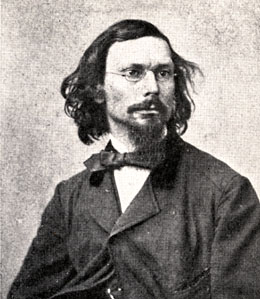| George Inness  Born: 1-May-1825 Born: 1-May-1825
Birthplace: Newburgh, NY
Died: 3-Aug-1894
Location of death: Bridge of Allen, Stirling, Scotland
Cause of death: unspecified
Remains: Buried, Rosedale Cemetery, Orange, NJ
Gender: Male
Race or Ethnicity: White
Sexual orientation: Straight
Occupation: Painter Nationality: United States
Executive summary: American landscape painter American landscape painter, born near Newburgh, New York, on the 1st of May 1825. Before he was five years of age his parents had moved to New York and afterwards to Newark, New Jersey, where his boyhood was passed. He would not "take education" at the town academy, nor was he a success as a green-grocer's boy. He had a strong bent towards art, and his parents finally placed him with a drawing-master named Barker. At sixteen he went to New York to study engraving, but soon returned to Newark, where he continued sketching and painting after his own initiative. In 1843 he was again in New York, and is said to have passed a month in Gignoux's studio. But he was too impetuous, too independent in thought, to accept teaching; and, besides, the knowledge of his teachers must have been limited. Practically he was self-taught, and always remained a student. In 1851 he went to Europe, and in Italy received his first glimpse of real art. He was there two years, and imbibed some traditions of the classic landscape. In 1854 he went to France, and there studied the Barbizon painters, whom he greatly admired, especially Daubigny and Rousseau. After his return to America he opened a studio in New York, then went to Medfield, Massachusetts, where he resided for five years. A pastoral landscape near this town inspired the characteristic painting "The Medfield Meadows." Again he went abroad and spent six years in Europe. He came back to New York in 1876, and lived there, or near there, until the year of his death, which took place at Bridge of Allan on the 3rd of August 1894 while he was travelling in Scotland. He was a National Academician, a member of the Society of American Artists, and had received many honors at home and abroad. He was married twice, his son, George Inness (b. 1854), being also a painter.
Inness was emphatically a man of temperament, of moods, enthusiasms, convictions. He was fond of speculation and experiment in metaphysics and religion, as in poetry and art. Swedenborgianism, symbolism, socialism, appealed to him as they might to a mystic or an idealist. He aspired to the perfect unities, and was impatient of structural foundations. This was his attitude towards painting. He sought the sentiment, the light, air, and color of nature, but was put out by nature's forms. How to subordinate form without causing weakness was his problem, as it was Corot's. His early education gave him no great technical facility, so that he never was satisfied with his achievement. He worked over his pictures incessantly, retouching with paint, pencil, coal, ink -- anything that would give the desired effect -- yet never content with them. In his latter days it was almost impossible to get a picture away from him, and after his death his studio was found to be full of experimental canvases. He was a very uneven painter, and his experiments were not always successful. His was an original -- a distinctly American -- mind in art. Most of his American subjects were taken from New York state, New Jersey and New England. His point of view was his own. At his best he was often excellent in poetic sentiment, and superb in light, air and color. He had several styles: at first he was somewhat grandiloquent in Roman scenes, but sombre in color; then under French influence his brush grew looser, as in the "Grey Lowering Day"; finally he broke out in full color and light, as in the "Niagara" and the last "Delaware Water-Gap." Some of his pictures are in American museums, but most of them are in private hands.
Wife: George Inness (painter, b. 1854)
Do you know something we don't?
Submit a correction or make a comment about this profile
Copyright ©2019 Soylent Communications
|